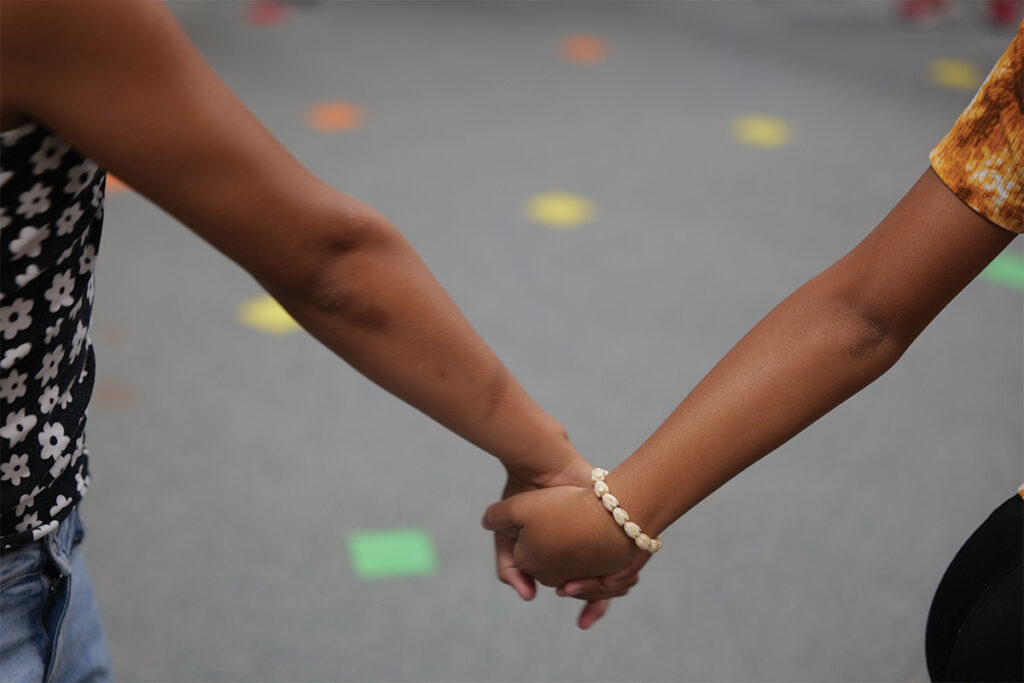Our Hawaiʻi public schools believe every student deserves a safe, respectful learning environment—both in school and online. Fa'amata'u, in any form, undermines the well-being and success of students. That’s why we are committed to empowering students, families and communities with tools and resources to prevent and address bullying. From proactive prevention programs to easy-to-use reporting tools like the Tautala Nei HIDOE app, matou te galulue felagolagoma'i ma o matou nu'u e fa'alauiloa se aganu'u o le fa'aaloalo, matafaioi ma le lagona alofa. Fa'atasi, e mafai ona tatou fa'amautinoa e lagona e tamaiti a'oga uma le lagolagoina ma le saogalemu, ina ia mafai ai ona latou fa'atupuina a'oa'oga ma fa'alagona.

What is Fa'amata'u?
Fa'amata'u is a serious issue that affects students of all ages and backgrounds. While there are many forms of bullying, we’ll be focusing on two primary categories: bullying ma cyberbullying. Understanding these two types is important so we can all work together to create a safer and more respectful school environment.
“Bullying”—so’o se faiga tusitusia, tautala, ata, po’o se gaioiga fa’aletino e fa’atiga, fa’aleagaina, fa’alumaina pe fa’amata’u ai se tamaititi aoga, e aofia ai i latou o lo’o i ai tulaga puipuia o le vasega, ua lava le ogaoga, faifai pea, po’o le sosolo e fa’atupu ai se si’osi’omaga fa’amata’u, taufa’amata’u, po’o le sauaina.
“Cyberbullying”—electronically transmitted acts, including but not limited to those transmitted through the Internet, cell phone, or other wireless hand-held device initiated by one student toward another student or employee of the department that hurts, harms, humiliates, or intimidates the student or employee; and is sufficiently severe, persistent or pervasive, that it creates an intimidating, threatening, or abusive educational environment. Cyberbullying can occur:
- I luga o le lotoa, po'o isi nofoaga a le matagaluega, i felauaiga a le matagaluega, po'o le taimi o se fa'agaioiga po'o se fa'afiafiaga a le matagaluega i totonu po'o fafo atu o fanua a'oga;
- E ala i se faiga fa'amaumauga a le matagaluega e aunoa ma ni feso'ota'iga fa'atagaina a le matagaluega; pe
- E ala i se feso'ota'iga komepiuta i fafo atu o le lotoa, pe a a'afia le si'osi'omaga a'oga.
Additionally, cyberbullying may also be based on a person’s protected class, including but not limited to, a person’s race, color, religion, sex, sexual orientation, gender identity, gender expression, age, national origin, ancestry, disability, physical appearance and characteristics, and socio-economic status.
ReporT bullying with our App
HIDOE has an app that allows students to report bullying incidents. Our Tautala Nei HIDOE Lipoti App offers elementary, middle and high school students a way to report bullying incidents—digitally and anonymously, if they choose—that happen on campus, on HIDOE transportation, or at HIDOE-sponsored events.
- Matamata i vitio o loʻo i lalo mo se faʻataʻitaʻiga taʻitasi i le auala e tuʻuina atu ai se faʻamatalaga e faʻaaoga ai le app.
- Tautala Nei HIDOE Lipoti App Flyer (PDF)
Auala e Tuuina atu ai se Fautuaga
Tamaiti A'oga Maualuga i Vasega 7-12
Tamaiti A'oga Tulagalua ile Vasega 4-6
managing bullying
Fa'amata'u is a Community Issue
Fa'amata'u belongs to all of us. School staff can address incidents and support students at school, but they cannot stop bullying—in all its forms, and in all the places it occurs—on their own. Families, students, and communities have a role to play to adopt and promote a culture of respect, responsibility and resiliency.
Matou te uunaia aiga e talanoa ma a latou fanau e uiga i le faaaloalo ma le agaalofa i isi, e aofia ai i latou e ese mai ia i latou lava. I totonu oa matou aʻoga, matou te faʻaleleia nei uiga o se vaega o Nā Hopena Ao, social-emotional learning, and other efforts. While bullying can happen to anyone, students may also be targeted because of race, socio-economic status, sexual orientation, gender identity, learning disabilities and other qualities; a violation of tulafono o aia tatau.
Community-wide strategies can help identify and support children who are bullied, redirect the behavior of children who bully, and change the attitudes of adults and youth who tolerate bullying behaviors in peer groups, schools, families and communities.
Any child who is bullied or who witnesses a bullying incident is encouraged to tell a trusted adult or report it using the Speak Now HIDOE app. If an incident happens on our school campuses, on HIDOE transportation, or during a HIDOE-sponsored event, appropriate school personnel will investigate.
Our Response to Fa'amata'u
- Puipuiga: All schools are invested in building a positive school culture and climate to encourage all students to be respectful and empathetic. To address bullying behaviors schools may be implementing one or more of the following:
- Fa'ata'ita'iga lelei a le a'oga e a'oa'o ai tamaiti a'oga ia fa'aaloalo, fa'atatau ma a'oa'o alofa.
- Anti-Bullying Programs: Communities are unique, and schools have different approaches based on their community’s needs. Some schools have students leading their anti-bullying efforts.
- Fa'apa'aga i Nuu ma Afioaga: E tele a'oga latou te fa'atupuina mafutaga ma lala sooupu a le nu'u, tausi soifua maloloina ma le soifua manuia, leoleo ma fa'alapotopotoga fa'aleoleo, faufautua fa'aloia, foma'i fa'aleaganu'u ma isi e fa'alautele ai le lagolago.
- Tali: A tupu se fa'alavelave, e su'esu'e e le puleaoga po'o lana sui filifilia e:
- Fuafua pe o se Solitulafono e pei ona fa'amalamalamaina e Hawai'i Administrative Rules (HAR) Mataupu 19 (PDF) tupu.
- Fai se fa'amaumauga i totonu o le database lagolago a tamaiti a'oga, lea e mafai ai e a'oga ona fa'ailoa, mata'itu ma siaki atugaluga a tamaiti a'oga i le aluga o taimi.
- Mulimuli ai: School staff provide supports to victims and bullies to address ongoing conditions that may have contributed to the bullying incident and to help prevent future incidents. These conditions may include issues at home, stress, abuse, and health, social-emotional and behavioral health issues, among others.
Amioga leaga ma amio pulea a tamaiti aoga
Mataupu 19
Hawaiʻi Administrative Rules, Chapter 19, faʻatonutonu mataupu e fesoʻotaʻi ma amio le pulea a tamaiti aʻoga, which includes bullying, harassment and cyberbullying. It’s important that students and parents review this information to be aware of what constitutes a Chapter 19 violation, and what the consequences are.
La'u mai le tulafono a le Hawai'i Administrative Rules, Mataupu 19:
- Sipaniolo (PDF)
- Tagalog (PDF)
- Thai (PDF)
- Toga (PDF)
- Vietnamese (PDF)
Mataupu 19 Tusi a Matua Faaliliu
E iloa e le Matagaluega le mana'omia o nei tusi taua e fa'aliliu i a latou lava gagana mo o tatou aiga e toe iloilo ma la'u mai ai. E aofia ai:
- Mataupu 19 Tusi a Matua
- A'upega Matua Tusi
- Fa'aeletonika Ulaula Tusi Matua
- Igilisi
- Hawaii (o loma)
- Sepuano
- Saina (Fa'afaigofie)
- Saina (Fa'aleaganu'u)
- Chuukese
Su'esu'ega o Amioga Tu'u Tulaga Talavou
O le Youth Risk Behavior Survey (YRBS) e mata'ituina le lautele o amioga e feso'ota'i ma le soifua maloloina i tamaiti a'oga maualuga, e aofia ai amioga e lamatia ai le soifua maloloina e saofagā i manu'a ma sauaga e le'i mafaufauina; fa'aoga tapaa; ava malosi ma isi fualaau faasaina; amioga fa'afeusuaiga e feso'ota'i ma ma'itaga e le'i fuafuaina ma fa'ama'i pipisi; amioga le lelei o taumafa; ma le le gaoioi faaletino. O le YRBS o lo'o fa'atinoina i isi tausaga ta'itasi fa'atasi ma se taumafaiga a le atunu'u e aoina fa'amaumauga ma au'ili'iliga a le Nofoaga Autu mo Fa'ama'i ma Puipuiga. The Hawaiʻi YRBS is a joint effort of the Hawaiʻi State Departments of Education (HIDOE), Department of Health (DOH), and the University of Hawaiʻi’s Curriculum Research & Development Group. The Hawaiʻi YRBS data and reports are available on the Hawaii'i Health Data Warehouse.
